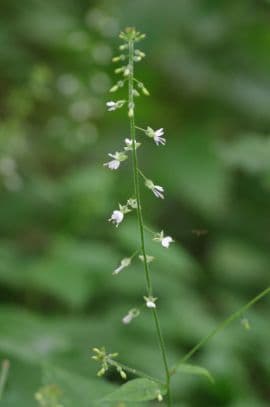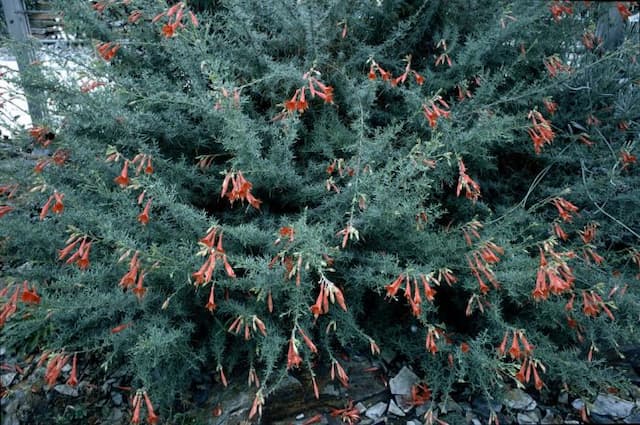Golden Fuchsia Fuchsia magellanica var. gracilis 'Aurea'

ABOUT
Fuchsia magellanica var. gracilis 'Aurea', commonly known as hardy fuchsia or hummingbird fuchsia, is renowned for its striking appearance and is popular in ornamental gardens. It features beautiful golden-green foliage that serves as a vivid backdrop for its drooping, tube-like flowers. The leaves are delicate and slightly elongated, with a soft texture, appearing almost luminescent when sunlight filters through them. The flowers are a visual delight, displaying a delightful blend of deep purple and red hues. They dangle gracefully from the branches, resembling elegant earrings, with the petals flaring out at the bottom in a skirt-like fashion. The stamens protrude from the corolla, typically in a contrasting pink or purple shade, adding a further splash of color to the overall display. The vibrant blossoms of this plant are known to attract a range of pollinators, particularly hummingbirds, who are enticed by the flowers' rich nectars and striking colors. The combination of the luminous foliage and the colorful, pendulous flowers creates a spectacular ornamental feature in gardens, offering a continuous display of beauty through multiple seasons.
About this plant
 Names
NamesFamily
Onagraceae.
Synonyms
Golden Fuchsia, Hummingbird Fuchsia, Yellow-Leaved Magellan Fuchsia, Golden-Leafed Fuchsia.
Common names
Fuchsia magellanica var. gracilis 'Aurea'.
 Toxicity
ToxicityTo humans
The hardy fuchsia is not considered toxic to humans. There are generally no significant toxicity concerns for people regarding this plant. Therefore, accidental ingestion of the hardy fuchsia typically does not cause any symptoms of poisoning or serious consequences.
To pets
The hardy fuchsia is also not considered toxic to pets. It is generally safe around animals, and there are no major toxicity risks for pets who might ingest parts of this plant. Thus, pets that consume the hardy fuchsia usually do not experience any symptoms of poisoning or adverse health effects.
 Characteristics
CharacteristicsLife cycle
Perennials
Foliage type
Deciduous
Color of leaves
Green
Flower color
Mixed
Height
4-5 feet (1.2-1.5 meters)
Spread
4 feet (1.2 meters)
Plant type
Shrub
Hardiness zones
6-9
Native area
Southern Chile Argentina
Benefits
 General Benefits
General Benefits- Ornamental Appeal: Adds vibrant colors to gardens with its striking flowers and golden foliage.
- Attracts Wildlife: Draws in hummingbirds and beneficial pollinators such as bees and butterflies.
- Long Flowering Season: Provides visual interest from late spring through early fall with its long blooming period.
- Shade Tolerance: Adapts well to partial shade, making it versatile for different garden locations.
- Easy Pruning: Responds well to pruning, which can help maintain its shape and promote more vigorous growth.
- Cold Hardy: Capable of withstanding cooler temperatures, making it suitable for a range of climates.
- Soil Adaptability: Grows in a variety of soil types, as long as they are well-draining.
- Versatility: Suitable for use in borders, containers, and as a focal point in a mixed bed.
 Medical Properties
Medical PropertiesThis plant is not used for medical purposes.
 Air-purifying Qualities
Air-purifying QualitiesThis plant is not specifically known for air purifying qualities.
 Other Uses
Other Uses- Fuchsia can be used as a natural dye. The flowers and berries of the fuchsia plant, including Fuchsia magellanica var. gracilis 'Aurea', can be boiled to produce a beautiful dye for fabrics or art projects.
- Fuchsia berries are edible and can be used in recipes. Though not commonly consumed, the berries of some fuchsia species are edible and can be added to salads or used in jams and jellies.
- Ornamental fish ponds can benefit from fuchsia plants. Planted around the edges, they can provide shade and shelter for fish while also enhancing the pond's aesthetic appeal.
- Fuchsia plants can be used in mixed hedgerows for wildlife. The dense foliage and flowers can offer nesting opportunities and a food source for birds and insects.
- The plant's branches can be used in basket weaving. Flexible young shoots of Fuchsia magellanica can be woven into ornamental or functional baskets.
- Garden sculpture frameworks can be adorned with fuchsia vines. The vines can be trained around metal frameworks to create living sculptures in the garden.
- Fuchsia can be a teaching tool for botany enthusiasts. Its unique flower structure offers a distinctive example of plant anatomy and pollination strategies.
- Culinary garnishes can be made from fuchsia flowers. The vivid flowers can be used to add color and decoration to plates in high-end culinary presentations.
- Fuchsia can contribute to sensory gardens. With its vibrant colors and soft textures, it is especially appealing for gardens designed for sensory stimulation.
- Fuchsia plant remnants can be used as mulch. After pruning or at the end of the season, the plant material can be composted and used to mulch garden beds.
Interesting Facts
 Feng Shui
Feng ShuiThe Hard Fuchsia is not used in Feng Shui practice.
 Zodiac Sign Compitability
Zodiac Sign CompitabilityThe Hard Fuchsia is not used in astrology practice.
 Plant Symbolism
Plant Symbolism- Grace – The elegant drooping shape of Fuchsia flowers, especially Fuchsia magellanica var. gracilis 'Aurea', symbolizes grace and poise.
- Confidence – With its bold colors and unique flower form, the Fuchsia represents confidence and assertiveness.
- Good taste – Often associated with sophistication and good taste due to its ornamental beauty.
- Elegance – The delicate appearance and intricate structure of the Fuchsia blooms are emblematic of elegance and refinement.
- Harmony – The blending of the colors in Fuchsia flowers signify a harmonious balance, reflecting the plant’s ability to combine different shades seamlessly.
- Achievement – The Fuchsia plant, when it thrives and blooms profusely, is sometimes seen as a symbol of personal achievement and pride in one's accomplishments.
- Intense passion – Particularly because of its vivid colors and vigorous growth, Fuchsia can signify deep love and heartfelt emotions.
 Water
WaterThe Hardy Fuchsia should be watered deeply whenever the top inch of soil feels dry to the touch. On average, this may be once or twice a week, but it's important to adjust frequency based on weather conditions. During the active growing season in spring and summer, you may need to water more frequently, especially in hot, dry spells. Ensure that the plant receives at least one gallon of water at each watering, allowing the moisture to reach the roots without waterlogging the soil. Decrease watering in the fall and winter when the plant goes dormant, making sure the soil doesn't dry out completely.
 Light
LightHardy Fuchsia thrives in a spot that offers morning sun and afternoon shade, or dappled sunlight throughout the day. Avoid placing the plant in direct, hot afternoon sun as this can lead to scorching of the leaves. The plant performs best with a few hours of gentle sunlight and then protected or indirect light that simulates its native understory habitat.
 Temperature
TemperatureHardy Fuchsia prefers cooler temperatures and can tolerate a range from 40 to 75 degrees Fahrenheit. It can survive short periods of colder temperatures down to about 30 degrees Fahrenheit, but frost can damage the plant. The ideal temperature range for thriving growth is between 55 and 70 degrees Fahrenheit, ensuring the plant is protected from extreme heat and cold.
 Pruning
PruningPruning the Hardy Fuchsia helps to maintain its shape, encourage bushier growth, and remove dead or damaged stems. Prune in late winter or early spring before new growth begins, cutting back the previous year's growth by about a half to maintain the desired size and shape. Regular deadheading of faded flowers during the blooming season will also promote more blooms. Pruning can be done annually or as needed to rejuvenate the plant.
 Cleaning
CleaningAs needed
 Soil
SoilHardy Fuchsia prefers well-drained, fertile soil with consistent moisture. A mix of two parts peat moss, one part loam, and one part perlite or sand creates an ideal medium. The best pH range for this plant is slightly acidic to neutral, around 6-7.
 Repotting
RepottingHardy Fuchsias should be repotted every 2-3 years, or when they become root-bound. Early spring, before the onset of new growth, is the optimal time for repotting this plant.
 Humidity & Misting
Humidity & MistingHardy Fuchsia thrives in moderate to high humidity levels. Maintain humidity around 60-70% for optimal growth, avoiding excessively dry or draughty conditions.
 Suitable locations
Suitable locationsIndoor
Place in bright, indirect light and avoid dry air indoors.
Outdoor
Position in dappled shade and shelter from strong winds.
Hardiness zone
6-9 USDA
 Life cycle
Life cycleFuchsia magellanica var. gracilis 'Aurea', commonly known as Hardy Fuchsia, begins its life cycle as a seed, which germinates in moist, well-drained soil in spring to early summer. The seedling then develops into a young plant with characteristic golden-green foliage and the initial set of true leaves appears. As it matures, Hardy Fuchsia enters a vegetative stage, growing stems and leaves, and in suitable climates, it becomes a woody perennial shrub. The plant proceeds to the flowering stage, usually in late spring to summer, producing pendulous teardrop-shaped flowers with a combination of purple and red hues that attract pollinators. After pollination, flowers develop into small, dark purple fruits, which can disperse seeds for the next generation, completing the reproductive cycle. In cold climates, Hardy Fuchsia may die back to the ground in winter but can resprout from the base in spring if the roots are well-protected.
 Propogation
PropogationPropogation time
Late spring-summer
Fuchsia magellanica var. gracilis 'Aurea', commonly known as Hardy Fuchsia, is commonly propagated by softwood cuttings. The best time for taking cuttings is late spring to early summer when the plant is actively growing. To propagate by cuttings, one should select a healthy shoot and cut a 3- to 5-inch (7.5 to 12.5 cm) stem piece, just below a leaf node. The lower leaves are removed, and the cut end is dipped in rooting hormone powder to encourage root growth. The cutting is then placed in a pot with well-draining soil, watered lightly, and covered with a plastic bag to maintain humidity. The cutting should be kept in a warm, indirect-light location until new growth indicates rooting, typically several weeks later. Once the cutting has rooted and new growth is evident, it can be transplanted into a suitable location in the garden or a larger pot.









